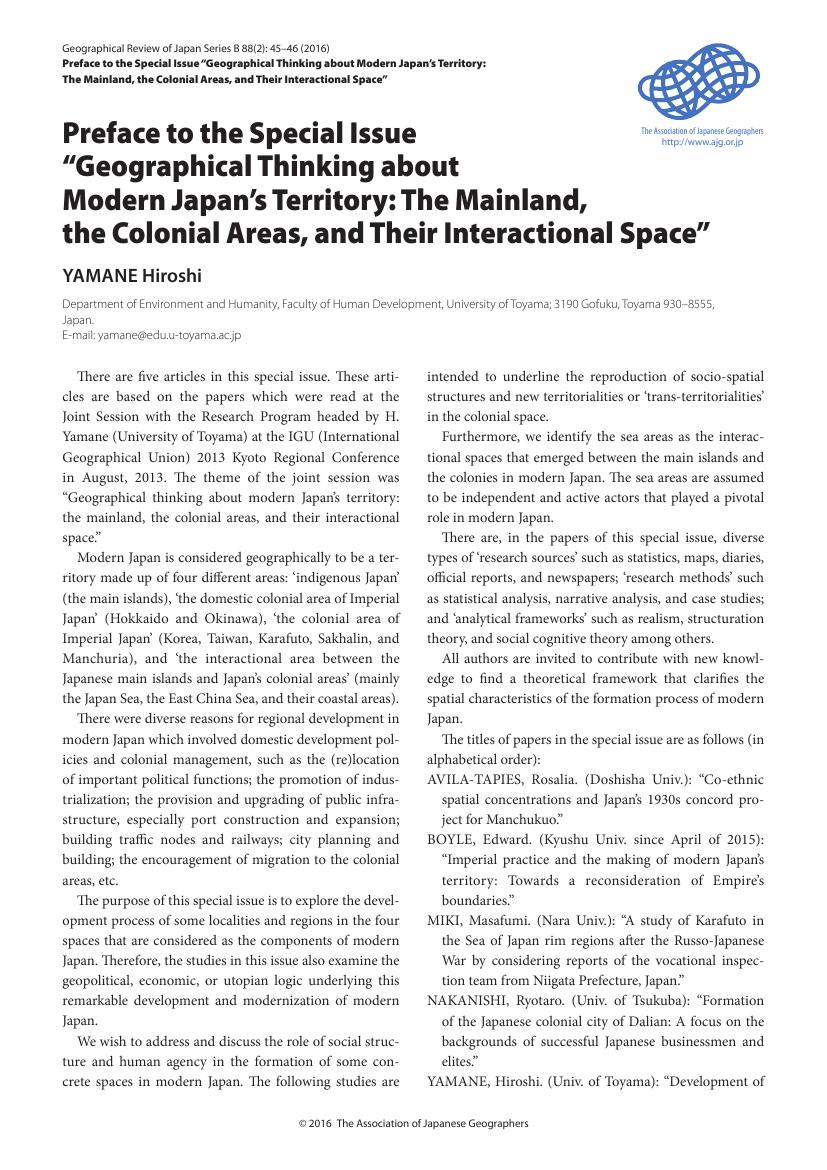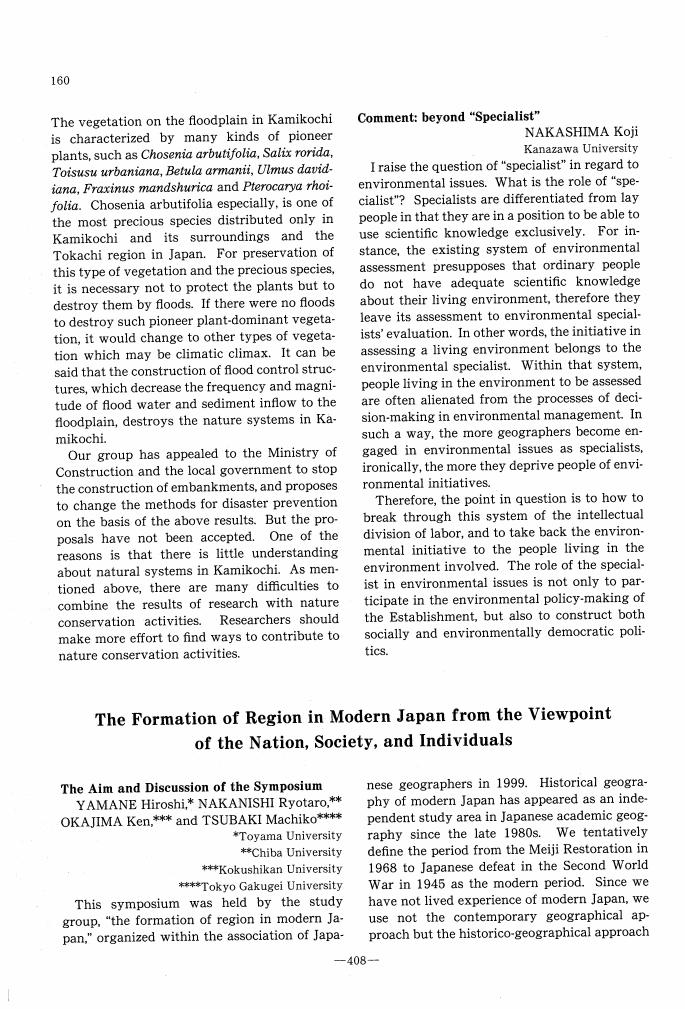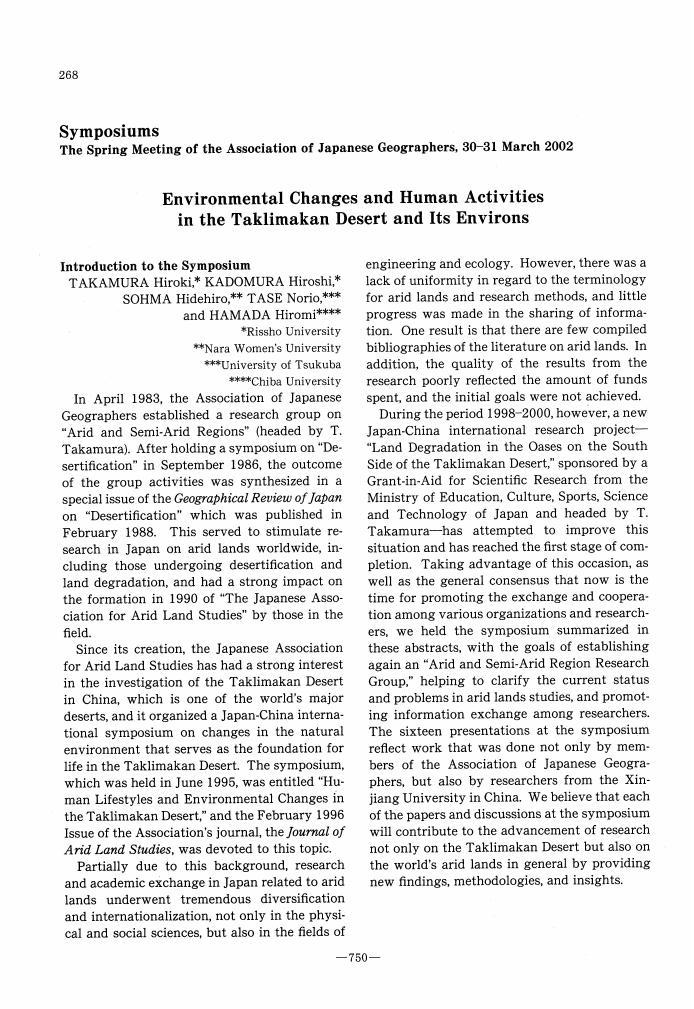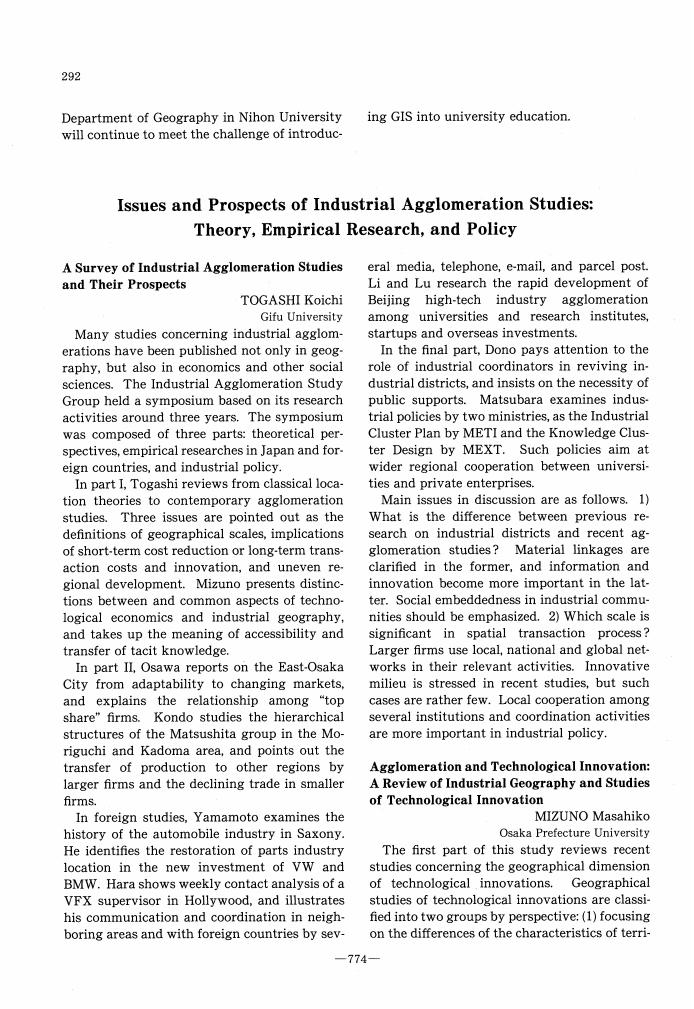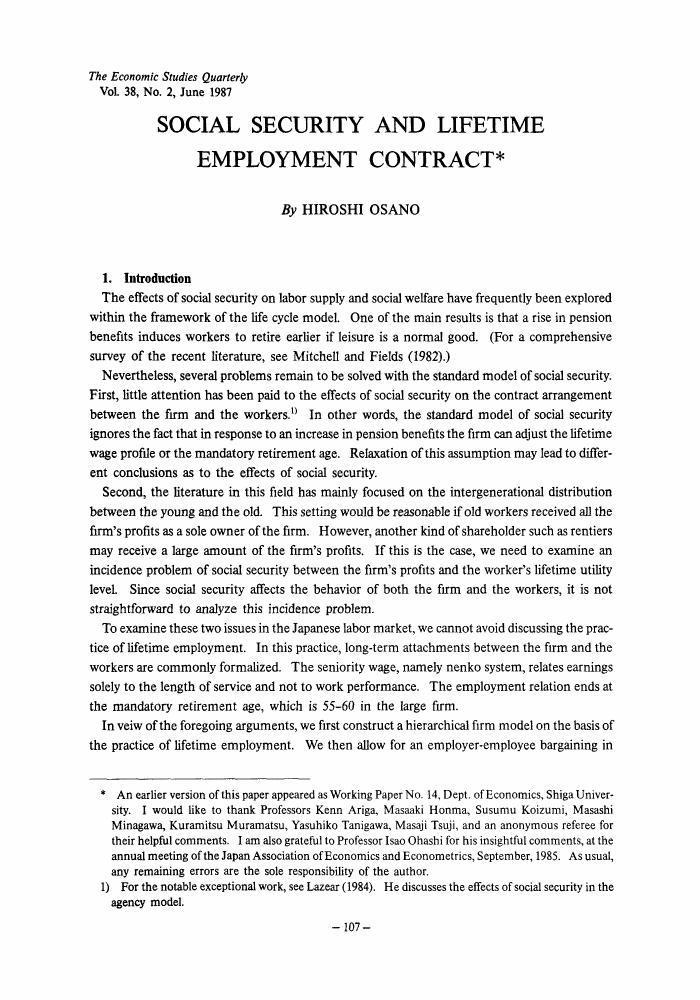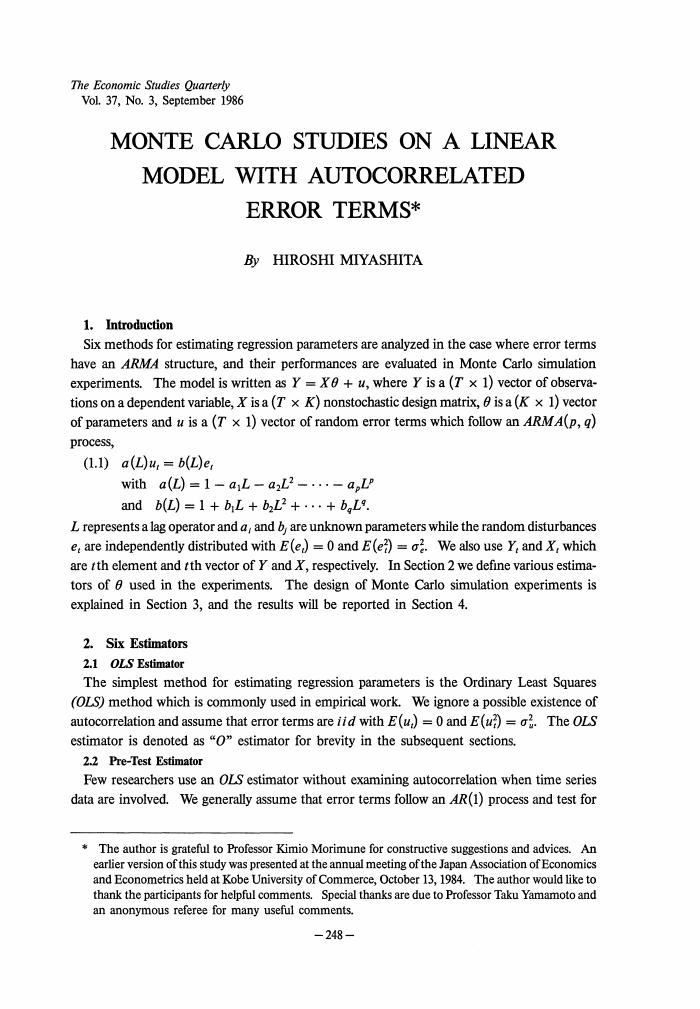- 著者
- Hiroshi SASAKI
- 出版者
- The Association of Japanese Geographers
- 雑誌
- Geographical review of Japan, Series B (ISSN:02896001)
- 巻号頁・発行日
- vol.70, no.2, pp.74-82, 1997-12-01 (Released:2008-12-25)
- 参考文献数
- 31
Unification of Germany has put East Germany in the position of being a laboratory, a good example of areal changes in the world. At the time of unification the share of East Germany in the whole German GDP was only 7.2% in 1991, but owing to large transfers for East Germany and to the foreign investments, it became 10.9% in 1995. Unification of the currency brought a favorable exchange rate (1 : 1) for East German, but it caused a weakening of the competitive power of East German industries on the world market. All state owned properties and enterprises were put under the control of Treuhandanstalt, which reprivatised, privatised or sold them to West German or foreign companies. Many profitable enterprises were bought as “fillet” by West German big companies and the rest as “fat and bone” by foreign companies, among which French, USA and British dominated. The areal structure of economy in East Germany was worked out by some geographers during the age of DDR (German Democratic Republic), but none have yet tried, because the time is not sufficient since the unification of Germany. The contrast between “Industrial South and Agricultural North” is very clear and rooted in natural conditions and in a long history. Five such economic regions may be distinguishable: agro-industrial region along Baltic coast, agricultural region on lowland in the Middle, mining and industrial region in the South, Sachsen=Thüringen industrial region, and Berlin.
1 0 0 0 OA Development of Important Ports and Sea Areas in the Territorial Expansion of Modern Japan
- 著者
- YAMANE Hiroshi
- 出版者
- The Association of Japanese Geographers
- 雑誌
- Geographical review of Japan series B (ISSN:18834396)
- 巻号頁・発行日
- vol.88, no.2, pp.96-110, 2016-09-30 (Released:2016-09-30)
- 参考文献数
- 23
- 被引用文献数
- 1 1
After the opening of Japan and the Meiji Restoration in the 1850s–1860s, the Japanese land space changed drastically with domestic restructuring and the expansion of overseas colonies. In the process, the stronger presence of Japan in Northeast Asia was accompanied by the reinforcement of the ports on the shores of the Japan Sea and the East China Sea. Some good natural ports on the mainland competed with rival ports in supplying services for the continent and in harbor improvements, and became positioned as pivotal nodes for international trade or passenger transit in the Northeast Asian network. This paper focuses on two successful ports, Tsuruga and Nagasaki, and explores two problems from the perspective of ‘realism-structuration.’ One is how locally influential individuals as special human agencies contributed to the regional formation of these ports through their time-space practices in the expansion process. The other is how they recognized and understood or experienced the sea areas surrounding the Japanese mainland and the continental area. Two key people, Owada in Tsuruga and Suzuki in Nagasaki, actively visited the continental area, and insisted on and practiced development of their localities in close relationship with the continental area. In this sense, they were special human agencies precisely embodying the structure that provided regional formation. Finally, the following inference is made: In a multilateral area as an actor-network, from the viewpoint of Actor-Network Theory, the sea areas became involved in the networking as non-human actors.
- 著者
- YAMANE Hiroshi
- 出版者
- The Association of Japanese Geographers
- 雑誌
- Geographical review of Japan series B (ISSN:18834396)
- 巻号頁・発行日
- vol.88, no.2, pp.45-46, 2016-09-30 (Released:2016-09-30)
- 著者
- MATSUHASHI Koji MIZUNO Masahiko KASHIMA Hiroshi ODA Hironobu
- 出版者
- The Association of Japanese Geographers
- 雑誌
- Geographical review of Japan series B (ISSN:18834396)
- 巻号頁・発行日
- vol.86, no.1, pp.82-91, 2013-07-30 (Released:2013-07-31)
- 参考文献数
- 95
- 被引用文献数
- 1 1
This paper aims to review geographical studies on manufacturing industries in Japan over the past two decades, with particular focus on industrial agglomeration, the geography of large manufacturing firms, and industrial regions. Academic discussions on industrial agglomerations in Japan have shared some common subjects with those in North America and Europe, but took a different direction from the latter in the Japanese economic context. Empirical studies on industrial agglomeration have been tackled from diverse viewpoints. It is not easy to sum up their main view. In order to prevent the discussion from scattering, empirical studies have to be particularly sensitive to the geographic scale and its spatial characteristics. It is also important that the many theoretical works, conducted more than in other countries, provide the common base of discussion in empirical studies. Since the 1990s, globalization has brought about a rise in foreign direct investment in Asia through Japanese multi-national enterprises (MNEs), and at the same time, “hollowing out” of industries appeared on the Japanese manufacturing landscape. However, studies on shifting spatial systems within Japanese manufacturing remain insufficient in their attempt to understand the real character of spatial systems in terms of the international division of labor in East and South Asia. It is necessary to take up the following three issues both theoretically and empirically: first, the production systems of the Japanese MNEs in East and South Asian countries; second, inter-regional and international division of labor in East and South Asia; and third, the repercussions of locating abroad and offshoring manufacturing on industrial regions within the home country. Relocation abroad and offshoring of manufacturing have brought about an unequal development among industrial regions. Empirical work on the economic and social effects through the increasing reorganization of industrial regions has emerged as important. In addition to these issues, seeking an alternative system of local manufacturing for survival, creating high-value-added jobs and innovative activities, poses the emerging challenge in the study of this sphere.
- 著者
- Kunihiko ENDO Itsuki NAKABAYASHI Mitsuhisa WATANABE Fumio TSUNODA Hidehiko KAZAMA Jun-ichi YOSHINO Yasuhiro SUZUKI Hiroyuki SAKAUE Minoru SHIMIZU Hiroshi UNE
- 出版者
- The Association of Japanese Geographers
- 雑誌
- 地理学評論 (ISSN:13479555)
- 巻号頁・発行日
- vol.79, no.12, pp.738-743, 2006-10-01 (Released:2008-12-25)
- 被引用文献数
- 1 1
- 著者
- Yasushi MOTOKI Toshikazu TAMURA Takeshi ISHIDA Takanobu SOTOME Takemi KOGURE Hiroshi SAWAGUCHI Kunio YOSHIKAWA Yasushi MOTOKI Kazuko UCHIDA Hiroki TAKAMURA Atsunao MARUI Akinobu MIYAKOSHI Takeshi HAYASHI Hiroshi KODAMA Nobuyuki KOMURO Naoyoshi SATO
- 出版者
- The Association of Japanese Geographers
- 雑誌
- 地理学評論 (ISSN:13479555)
- 巻号頁・発行日
- vol.79, no.12, pp.746-750, 2006-10-01 (Released:2008-12-25)
- 著者
- Yasuhiro SUZUKI Hiroshi UNE Kunihiko ENDO Takehiko SUZUKI Itsuki NAKABAYASHI Kotaro YAMAGATA Ikuo SUZUKI Takashi SHIMURA Yoshiyuki MURAYAMA Takashi TODOKORO Itsuki NAKABAYASHI P. Hiroshi SATO Mitsuhisa WATANABE Yohta KUMAKI
- 出版者
- The Association of Japanese Geographers
- 雑誌
- 地理学評論 (ISSN:13479555)
- 巻号頁・発行日
- vol.78, no.12, pp.867-872, 2005-10-01 (Released:2008-12-25)
- 著者
- Satoru ITOH Hiroaki AKIMOTO Koji ISHIZUKA Hideki FUKUDA Itsuo OHSHIMA Minori YUDA Satoru ITOH Yuuji KOSEKI Takanori SATO Tomoaki ITO Mamoru KOARAI Hiroshi UNE Kohei YAGUCHI Takeshi MINAMINO Tadamitsu SAITO
- 出版者
- The Association of Japanese Geographers
- 雑誌
- 地理学評論 (ISSN:13479555)
- 巻号頁・発行日
- vol.78, no.5, pp.321-325, 2005-04-01 (Released:2008-12-25)
1 0 0 0 OA Open Symposium “How Can We Make Hazard Map for Effective Reduction of Earthquake Damages”
- 著者
- Tokihiko MATSUDA Yasuhiro SUZUKI Takashi NAKATA Takashi KUMAMOTO Hiroshi UNE Kiyomine TERUMOTO Yoshiyuki MURAYAMA Takayuki NISHIYAMA Masaru YAMAGUCHI
- 出版者
- The Association of Japanese Geographers
- 雑誌
- 地理学評論 (ISSN:13479555)
- 巻号頁・発行日
- vol.77, no.12, pp.883-886, 2004-10-01 (Released:2008-12-25)
- 被引用文献数
- 1 1
- 著者
- Koji KOBAYASHI Satoshi NAKAGAWA Jozef MLAÁDEK Masahiro KAGAMI Peter MEUSBURGER Hiroshi SASAKI Koji KOBAYASHI Masaaki KUREHA Teresa CZYZ Ivan BICIK Martin HAMPL Antal AUBERT Jörg MATER Mitsuru YAMAMOTO Lidia SASAKI Shigeru YAMAMOTO
- 出版者
- The Association of Japanese Geographers
- 雑誌
- 地理学評論 (ISSN:13479555)
- 巻号頁・発行日
- vol.76, no.5, pp.392-403, 2003-04-01 (Released:2008-12-25)
- 著者
- Tatsuya ITO Toshihisa ASANO Tsukuru ISOBE Kenichi TOGAWA Tatsuya ITO Koichi KIMOTO Toshihisa ASANO Kayoko YAMAMOTO Hiroshi SHIMAZU NAKASHIMA Koji
- 出版者
- The Association of Japanese Geographers
- 雑誌
- 地理学評論 (ISSN:13479555)
- 巻号頁・発行日
- vol.76, no.5, pp.404-408, 2003-04-01 (Released:2008-12-25)
1 0 0 0 OA The Formation of Region in Modern Japan from the Viewpoint of the Nation, Society, and Individuals
- 著者
- Hiroshi YAMANE Ryotaro NAKANISHI Ken OKAJIMA Machiko TSUBAKI Akiko SEKIDO Toshio KAWASAKI Kouji AMANO Norifumi KAWAHARA Mitsuharu SHINADA Masafumi MIKI Keiichi KONO
- 出版者
- The Association of Japanese Geographers
- 雑誌
- 地理学評論 (ISSN:13479555)
- 巻号頁・発行日
- vol.76, no.5, pp.408-414, 2003-04-01 (Released:2008-12-25)
- 著者
- Hiroki TAKAMURA Hiroshi KADOMURA Hidehiro SOHMA Norio TASE Hiromi HAMADA Yuichi SUZUKI Akihiko INAMURA Hiroshi SHIMAZU Payzulla ZAYDUN Tsuyoshi OHTA Masaya YASUHARA Tashpolat TIYIP Tadashi KONO Hamid YIMIT Heigang XIONG Wei ZHONG Heigang XIONG Nurbay ABDUSALIH Peipou HUANG Hiroyuki SAWADA Hiroshi UMEMURA Kentaro SUZUKI Gulmira OMAR Kunihiko ENDO Motoko KANEMAKI Xiaoyu MA Jianli DING Jianqian ZHAN
- 出版者
- The Association of Japanese Geographers
- 雑誌
- 地理学評論 (ISSN:13479555)
- 巻号頁・発行日
- vol.75, no.12, pp.750-761, 2002-10-01 (Released:2008-12-25)
1 0 0 0 OA Issues and Prospects of Industrial Agglomeration Studies: Theory, Empirical Research, and Policy
- 著者
- Koichi TOGASHI Masahiko MIZUNO Katsufumi OHSAWA Akio KONDO Kenji YAMAMOTO Shinji HARA Guo-ping LI Ming-hua LU Satoshi DONO Hiroshi MATSUBARA
- 出版者
- The Association of Japanese Geographers
- 雑誌
- 地理学評論 (ISSN:13479555)
- 巻号頁・発行日
- vol.75, no.12, pp.774-779, 2002-10-01 (Released:2008-12-25)
1 0 0 0 OA THE FIRST MOMENT OF AN ORDINARY LEAST SQUARES ESTIMATE FOR BIVARIATE KOYCK DISTRIBUTED LAG MODELS
- 著者
- YUSAKU KATAOKA HIROSHI MIYASHITA KIMIO MORIMUNE
- 出版者
- JAPANESE ECONOMIC ASSOCIATION
- 雑誌
- The Economic Studies Quarterly (ISSN:0557109X)
- 巻号頁・発行日
- vol.41, no.3, pp.205-220, 1990-09-20 (Released:2007-10-19)
- 参考文献数
- 21
A class of models generalizing Koyck distributed lag models is applied to the problem of measuring market response Yt to a communications mix Zt-s consisting of media advertising or promotional expenditures. Rewriting these models as Yt=αYt-1+βZt+error term, α: 2×2, an ordinary least squares (OLS) estimate of α is obtained and the analytical expression for the first moment of an OLS estimate is derived under the assumption that Yt is normally and independently distributed. These results, in combination with an asymptotic expansion of the generalized hypergeometric function, yield a new approximate first moment formula for the OLS estimate.
1 0 0 0 OA IMPLICIT CONTRACTS AND REPUTATIONS
- 著者
- HIROSHI OSANO
- 出版者
- JAPANESE ECONOMIC ASSOCIATION
- 雑誌
- The Economic Studies Quarterly (ISSN:0557109X)
- 巻号頁・発行日
- vol.40, no.2, pp.109-121, 1989-06-20 (Released:2007-10-19)
- 参考文献数
- 23
- 著者
- HIROSHI OSANO
- 出版者
- JAPANESE ECONOMIC ASSOCIATION
- 雑誌
- The Economic Studies Quarterly (ISSN:0557109X)
- 巻号頁・発行日
- vol.38, no.2, pp.107-123, 1987-06-20 (Released:2008-02-28)
- 参考文献数
- 13
- 著者
- HIROSHI MIYASHITA
- 出版者
- JAPANESE ECONOMIC ASSOCIATION
- 雑誌
- The Economic Studies Quarterly (ISSN:0557109X)
- 巻号頁・発行日
- vol.37, no.3, pp.248-258, 1986-09-20 (Released:2007-10-19)
- 参考文献数
- 13
1 0 0 0 IR アルファー・シアノアクリレート樹脂による木材および木質材料の包埋と裏打ち法
- 著者
- Fujita Minoru Harada Hiroshi
- 出版者
- 京都大学農学部附属演習林
- 雑誌
- 京都大学農学部演習林報告 = BULLETIN OF THE KYOTO UNIVERSITY FORESTS (ISSN:0368511X)
- 巻号頁・発行日
- no.52, pp.216-220, 1980-12-25
一般に市販されているいわゆる瞬間接着剤のアロンアルファー201を用いて, 非常に簡便かつ迅速な樹脂包埋法を開発した。また通常のミクロトーム操作にも応用できる切片の"裏打ち"法を考案した。包埋法はFig 1に示すように, "(1) 乾燥した試片を試料台の上に置く。(2) アロンァルファー201を滴下して試片中に樹脂を浸透させる。(3) 余剰のアロンアルファーを濾紙で吸い取り約1時間放置する。"の手順で完了し, この包埋試片から0. 5 - 5μm厚さの切片がガラスナイフを用いて容易に切り出せる。包埋樹脂はアセトンで除去されるので, 切片は必要に応じて脱包埋できる。また切片作製後の試片をアセトンで脱包埋すると, 走査電顕観察に適した断面が得られる。この包埋法は木材はもちろん樹皮, 紙, 合板などの乾燥した多孔性の試料に適用できる。"裏打ち"法は湿潤試料に有効で, Fig 2に示すように, "(1) 試片をスラィディングミクロトームに装着し, 通常のミクロトーム操作で試料表面を平滑にする。(2) アロンアルファー201を滴下し余剰の液を濾紙で吸いとる。約1分後にはアロンアルファーは試料表面に固着する。(3) 5 - 20μm厚さの切片を切り出す。"以後 (2) (3) の操作をくり返す。切片はアロンアルファー膜で裏打ちされているので切削時の損傷が少なく, 軟弱な組織や, バラバラになりやすい組織の薄切に有効である。なお, アロンァルファーの裏打ち膜は必要に応じてアセトンで除去することができる。
1 0 0 0 OA Development of an in vivo-mimic silkworm infection model with Mycobacterium avium complex
- 著者
- Akiho Yagi Hiroyuki Yamazaki Takeshi Terahara Taehui Yang Hiroshi Hamamoto Chiaki Imada Hiroshi Tomoda Ryuji Uchida
- 出版者
- International Research and Cooperation Association for Bio & Socio-Sciences Advancement
- 雑誌
- Drug Discoveries & Therapeutics (ISSN:18817831)
- 巻号頁・発行日
- vol.14, no.6, pp.287-295, 2020-12-31 (Released:2021-01-23)
- 参考文献数
- 31
- 被引用文献数
- 5
In vivo-mimic silkworm infection models with Mycobacterium avium and Mycobacterium intracellulare were newly established to evaluate the therapeutic effects of anti-M. avium complex (MAC) antibiotics. Silkworms raised at 37°C died within 72 hours of an injection of M. avium or M.intracellulare (2.5 × 107 colony-forming unit (CFU)/larva·g) into the hemolymph. Clinical anti-mycobacterial (tuberculosis) antibiotics were evaluated under these conditions. Clarithromycin, kanamycin, streptomycin, amikacin, and ciprofloxacin exerted therapeutic effects in a dose-dependent manner, which was consistent with those in the mouse model. Furthermore, three effective actinomycete culture broths were selected in the screening program of our microbial broth library using the silkworm model, and four active metabolites, ohmyungsamycins A and B (1 and 2), chartreusin (3), and griseoviridin (4), were identified. Among these compounds, 1 showed the lowest 50% effective dose (ED50) value (8.5 µg/larva·g), while 3 had the best ED50/minimum inhibitory concentration (MIC) ratio (7.4). These results indicate that silkworm models are a useful tool for identifying anti-MAC antibiotics candidates with veritable therapeutic effects.
